Is Arm Day A Waste Of Time? Pros & Cons (Science-Backed) | PowerliftingTechnique.com (original) (raw)

We aren’t asking whether or not it’s worth training arm muscles (of course it’s worth it). The more important question is how you train your arms.
So, is a dedicated arm day a waste of time? Because arm muscles grow and develop in the same way as any other muscle in your body, arm days can be just as valuable and useful as any other workout split. An arm day can be effectively incorporated into a program based on your goals, training style, training frequency, and preference.
Now if you’re like me, you might wonder how this even became a question worth debating. And it all starts with bad information and plain old myths.
Arm Day Myths
Other writers on the internet have argued that arm days are a complete waste of time.
I’d like to share a few of those myths and debunk them here for you, once and for all.
Myth 1: “Big Muscles Should Be Prioritized Over Small Muscles”
This argument suggests that if a lifter focuses too much time on small muscles and neglects their “big muscles” then they will look disproportionate.
The biggest flaw in this argument is that it treats training as though these options are mutually exclusive (I can either train big muscles or small muscles), which makes zero sense. If you spend 1 hour a week training just your arms, it’s not taking anything away from your ability to train your back, legs, or chest.
Secondly, this myth makes no account for a lifter’s goals. We all lift for a variety of reasons – some to be competitively toned, some to be competitively big, some to be competitively symmetrical, some to be competitively strong. Others lift to strengthen a bad joint, improve their posture, improve overall health, or to lose weight.
This one-size-fits-all approach to training arms ignores all the reasons one might be lifting and simply cannot be blanketed across the entire population of people who participate in resistance training.
Myth 2: “Arm-Only Workouts Do Not Build Strength”
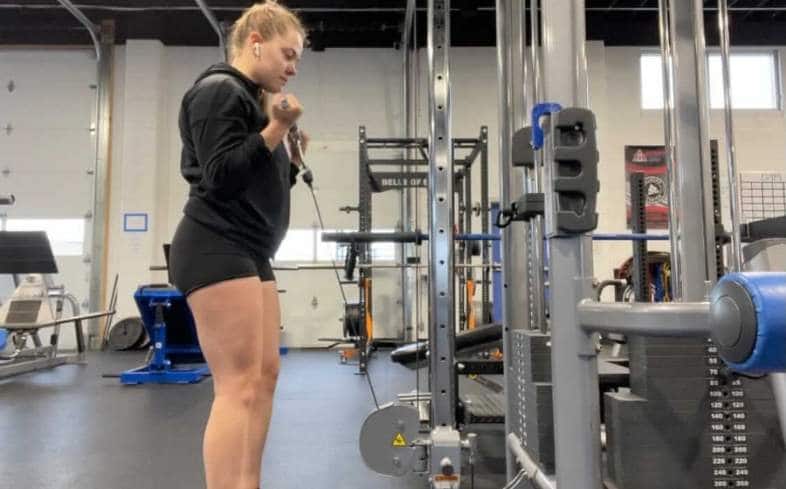
This argument suggests that we have to choose between strength and hypertrophy gains.
By training arms in a single workout, those who perpetuate this myth suggest that you can’t get stronger. One writer online even goes so far as to suggest “you don’t want to be the guy that looks like a 250lb bodybuilder who can only squat 135.”
I need to take a deep breath before I address this stupidity…
*takes a deep breath*
Being muscular and being strong are not mutually exclusive, which is the first flaw in this myth.
Training your arms once or twice a week in a dedicated arm workout will not take away from your ability to also train your squat, bench press, deadlift, or overhead press for maximal strength.
The best powerlifting programs I’ve ever seen (and I’ve reviewed many of them here) only call for a lifter to squat or deadlift 1-3x a week each, leaving you with at least 4 days of the week to train arms or upper body.
Second, just because the biceps curl or skull crusher is not used to demonstrate maximal strength with a 1-rep max doesn’t mean that they aren’t getting stronger every time you do a set of 10-12.
That’s why you have to keep adding weight, or adding more reps and increasing the intensity, even when you are performing high reps, because the muscle is adapting, growing, and getting stronger.
Arm days absolutely can build strength, even if you wouldn’t show off that strength with a 1 rep max.
Enhance your arm workout routine with our step-by-step guide on waiter curls.
Myth 3: “Training Arms Only Will Not Give You Bigger Arms”
I needed a deep breath before busting that last myth, but this one might require a defibrillator to get my heart going again after reading what some guys have written on the internet about this myth already.
I’m just going to quote from a blog I found that ranked very high in the Google search results on this topic, so you know I’m not making this up:
“When you do curls or tricep extensions, you’re not lifting a lot of weight. This means you’re not putting the muscle under a great amount of stress.”
This argument is entirely relative ‒ “Not lifting a lot of weight” ‒ relative to what? The author of this other article goes ahead and gives us his answer.
He suggests that a lifter who can curl 95lbs on a barbell would be able to perform underhand barbell rows with 185lbs, so the lifter should choose to do barbell rows and skip barbell curls, because heavier is better.
What’s missing with this argument is that the weight of a dumbbell or barbell alone does not determine the stress it puts on a muscle.
Sure, your biceps are engaged during an underhand barbell row, but your lats are doing most of the work ‒ it’s a compound lift.
A biceps curl, when performed correctly, is an isolated lift, focused entirely on the biceps doing all the work. Of course, your biceps can’t move as much weight as your lats and biceps combined. But they don’t need as much weight to create the stress.
Your arm muscles grow and adapt the same as any other muscle in your body. If 5lbs on a dumbbell puts enough stress on your biceps, it will grow. If you’ve trained a while and now you need 45lb dumbbells to introduce stress, they’ll keep growing. If the weight of your barbell row puts enough stress on your biceps, that’ll make them grow too.
Is Having An Arm Day Necessary For Mass?
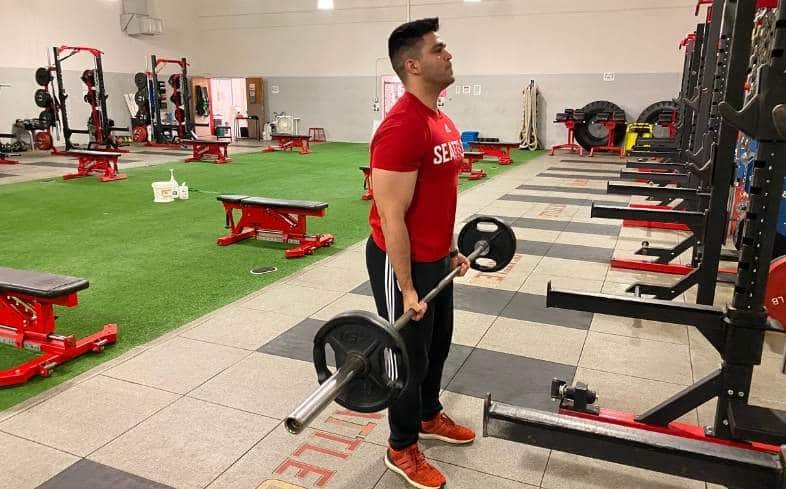
You might now wonder if an arm day is required to build mass in your arms. I’ll compile some research here to help you find the answer:
First, a muscle grows as stress is put upon it. This study states that “maximum gains in muscle hypertrophy are achieved by training regimens that produce significant metabolic stress while maintaining a moderate degree of muscle tension.”
Further research indicates that increased training frequency has a greater impact on muscle hypertrophy than performing the same volume once per week. In other words, how often you train a muscle can lead to greater increases in mass (i.e. training biceps twice per week is better than once per week).
Based on this research on training frequency, it appears that a bro split, where the arms are trained to exhaustion in a single workout, is not optimal.
However, if your arm day is supplemental to other upper body work (i.e. bench press day, upper body day, push/pull days, etc.), then you would be supporting the research above by adding additional training frequency on your arm muscles in the same week.
To answer the question, no, an arm day is not necessary for mass. But, it may be a useful approach when supplementing other arm work in the same week. This is especially the case if you have a goal of growing the size of your arms.
What absolutely is critical for arm mass is that you train them more than once per week, and you train them with intensity. It won’t matter if that’s all by themselves, or as part of other muscle groups or lifts.
Arm Day Benefits
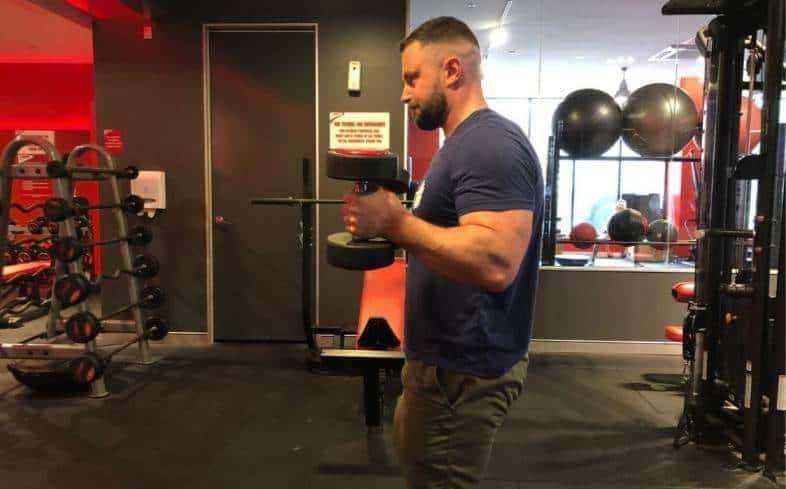
There are four major benefits to dedicated arm days.
- Increased training frequency
- Focus on weaknesses
- Focus on muscle isolation
- Increased volume
Increased Training Frequency
If we compare lifters who train their muscle groups once per week with lifters who perform the same amount of volume, but train their muscle groups twice per week, research shows superior results in the second group who trained their muscles more frequently.
By adding a dedicated arm day to your week, you can be adding the very important second training session for your shoulders, biceps, triceps, and forearms.
If you’re training your upper body some other day of the week, you’ll likely be engaging each of your arm muscles in some way or another while you perform pressing and rowing movements of all varieties, giving them their first stimulus of the week.
The dedicated arm day can become that second stimulus, helping you get maximal gains from your training each week.
Focus on Weaknesses
A dedicated arm day can also allow a lifter to focus on weak points in their arms that they don’t have time or energy to train in other workouts.
Personally, I’ve always had to work harder to keep my triceps growing as my bench press increases.
As a competitive powerlifter, I have dedicated bench press workouts where my triceps get a lot of work, both as they are used in the compound movements of the bench press and its variations, as well as in dedicated tricep exercises.
However, at times, I found adding an extra arm day allowed me to rest and recover my triceps from the bench press workout and come back to the gym to give them dedicated work to get them stronger to keep up with my pecs, shoulders, and back’s ability to bench press.
For many lifters, a dedicated arm day can give you the opportunity to focus on the specific arm muscles that need more volume and attention than they’ve been getting.
Focus on Muscle Isolation
In both examples above, I cited cases where your arms are getting activated in some way in compound movements.
Think of the bench press, the overhead press, pull-ups, cable rows, bent-over rows, dips. Each of these requires the use of your arms, but they all incorporate many other non-arm muscles.
In most cases, we categorize compound lifts by the largest muscle involved, which makes us ignore the arm muscles involved at times.
A dedicated arm day gives lifters a chance to train their arms in an isolated fashion, along with the compound movements you’re otherwise doing.
Increased Volume
There is some conventional wisdom out there when you reach a plateau, you should reduce your volume to start seeing gains again. However, some research has shown that some lifters benefit from increased volume.
For lifters like this, an added arm day might just be the added volume you need to keep your muscles adapting and growing as a result of the stress you put on them.
In this case, a dedicated arm day has a huge benefit, helping lifters get the necessary added volume, while having a chance to recover from previous arm work they’ve done that week.
Arm Day Drawbacks
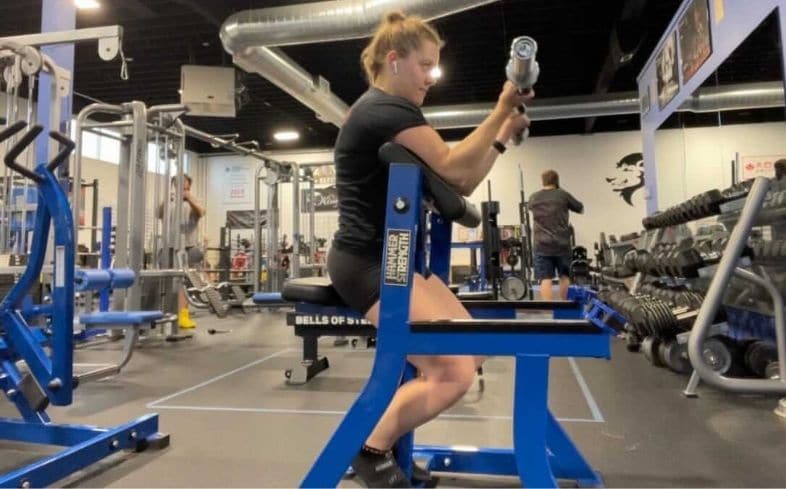
Even with the benefits I listed above, there are three drawbacks to a dedicated arm day:
- Take away from other work
- May conflict with your goals
- May not be the most effective
Take Away From Other Work
There are lots to train in the human body, and arms are just a piece of the pie.
If you can’t train a minimum of 3 days per week, then you might find other body parts are being neglected just simply because you aren’t getting enough time in the gym to train everything.
May Conflict With Your Goals
Not only are there other things you could be doing in the gym, but your goals will also dictate what you should be doing when you train.
If you are pressed for time each week, and you’re focused on other, more important goals like a stronger squat/bench/deadlift, better leg symmetry, better back development, rehabbing an injury, you name it ‒ an arm day might be a distraction from what you should be spending your time and energy on.
The whole reason you are in the gym is to reach those goals you’ve set for yourself, so let them be your guiding light and ditch the arm day if it’s not getting you closer to those goals.
May Not Be the Most Effective
Meta-analysis of several studies has shown that anything more than 8 sets per workout session may be best broken up over 2 or 3 workouts per week, supporting the research cited earlier.
If you’re approaching your arm day as your one day of the week to blast your arms with everything you got, you may not be getting the most effective workout in.
Take a step back and look at where else you can train arms in the week and try splitting it up. You’ll spend less total time in the gym and add frequency to your arm muscles, which is all a plus for efficiency.
When You Should & Shouldn't Do A Full Arm Day?
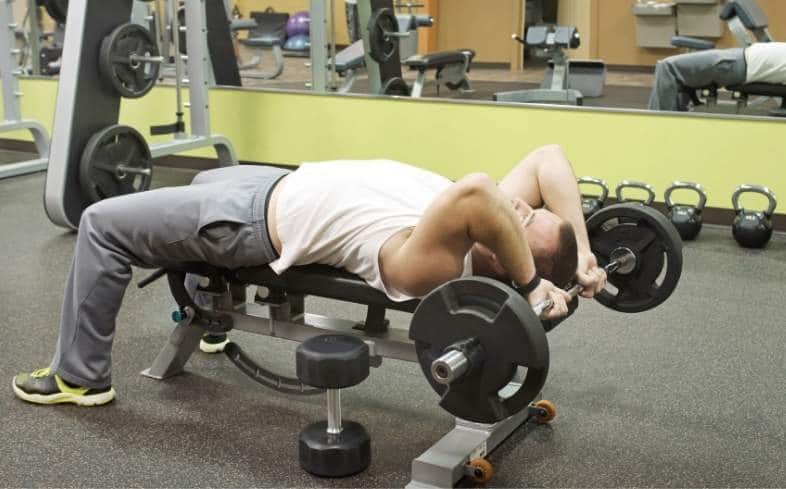
When I stop and think about it, I can think of three groups of people who should incorporate an arm day, and three groups of people who shouldn’t incorporate an arm day.
Do an Arm Day If:
You Need Added Volume in One or More of Your Arm Muscles
If you’re already training your arms hard, but not seeing enough improvement, you might be in the group of people who need more volume, so throw that extra arm day in for 8-12 weeks and track your results.
Your Arms Aren’t Getting Trained in Other Workouts
If you aren’t getting enough arm work in your other workouts, and still want to give your arms some love and attention, get yourself an arm day! Keep doing the other stuff you’re doing, but add in the arm day to round things out for yourself.
You Enjoy It
Bottom line is you gotta do what you actually enjoy. None of us would go to the gym much if we hated it, and the most important factor of all is consistency. If you enjoy a dedicated arm day, knock yourself out. Follow the guidelines I’ve presented here, keep your workouts intense and use good form, and you’ll see great results.
Do Not Do an Arm Day If:
You Have More Important Goals
Your time in the gym should be dictated by your goals. What you want to accomplish should shape what you train each day/each week in the gym. If you are focused on goals other than big/strong biceps or shoulders, make sure you prioritize those goals first.
If an arm day distracts you from those goals, cut it out and find a way to circle back to it once you’ve conquered the priorities in front of you.
Your Arms Get Trained a Lot Otherwise
There’s no magic in training arms by themselves. If you’re getting sufficient volume in your arms from your chest and back days, or other upper body work, you don’t need to stress. Muscles trained are muscles trained, no matter the split.
If you’re putting enough stimulus on your biceps from pull ups and rows, awesome. Don’t worry about adding more work when you’re already there (this is especially the case if you don’t have a goal of growing your arms).
You Don’t Enjoy It
If you hate it, don’t do it! There are many, many ways to get your arms effectively trained each week, and if a full workout of arm exercises makes you hesitate to go to the gym and workout, then I wouldn’t recommend it at all.
You gotta do what you enjoy, so follow what you like!
Alternatives To Doing An Arm Day?
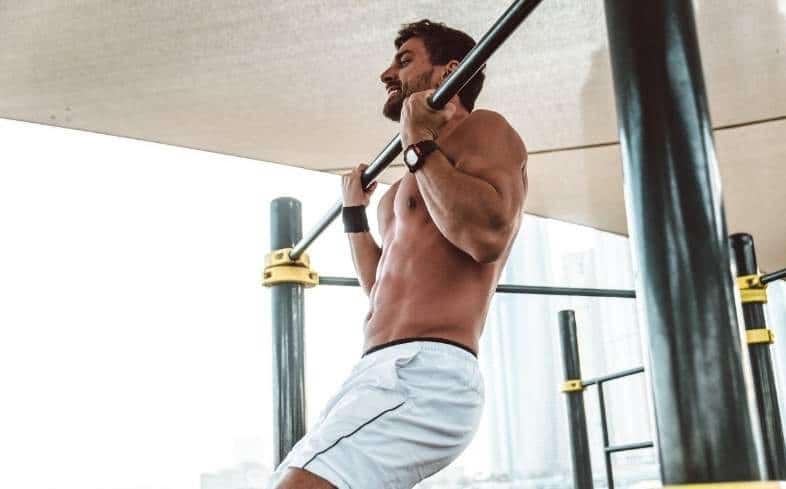
If a dedicated arm day isn’t for you, how else can you train your arms? Here are two of my favorite solutions:
Train Upper Body
Arms are just a focused subset of your upper body. There’s no reason you have to train them alone.
You might follow a Push/Pull split, which breaks up your upper body into motions that pull weight and motions and push weight. While many of these exercises mostly target your back or chest as the main muscle, they incorporate your arms and train the muscles in them.
You might follow a full upper body split, which doesn’t distinguish between the function of muscles, but instead aims to train your whole upper body in a single workout. Any upper body workout will require use of your arms in the same way the push/pull split will.
As long as you train these muscle groups 2+ times per week, you’ll be getting good arm work done each week and you can see size and strength gains.
Related Article: Can You Train Chest & Biceps On The Same Day?
Train Lifts, Not Muscles
Instead of thinking of your training as hitting muscles, think of training a lift itself, like the squat, bench press, or deadlift.
This is primarily how powerlifters structure their training, since their goal is not a particular size of their quads or pecs, but how well they can perform these lifts on competition day.
By training these three lifts, the muscles involved are all accounted for.
- By doing a full bench press workout, the lifter trains their chest, triceps, shoulders, back, and abs.
- By training the squat, the lifter trains their quads, hamstrings, glutes, lower back, upper back, and abs.
- By training deadlifts, the lifter trains their hamstrings, lower back, glutes, upper back, rear delts, forearms, and abs.
In the example of a bench press workout, the powerlifter will perform the standard bench press exercise, but also move on to do isolated exercises on the muscles involved, like the triceps and pecs.
If you were to train this way, your arms would get ample attention throughout the week as you focus on improving each lift.
Even if you aren’t interested in competing in powerlifting, you can still structure your training around compound lifts to check all the boxes of muscles you need to get trained each week.
Other Arm Training Resources
- Is It Okay To Bicep Curls Every Day?
- Does Bench Press Work Biceps?
- Is It Better To Do Bicep Curls Standing or Sitting?
- What Else Should I Do On Bicep Day? (4 Examples)
- Is It Better To Do Bicep Curls Fast or Slow?
- How To Even Out Biceps If One Is Bigger Than The Other?
- Is It Better To Do Bicep Curls One At A Time?
- Blood Flow Restriction Training For Arms (Complete Guide)
About The Author
Adam Gardner is a proud resident of Utah, where he lives with his wife and two kids. He has been competing in powerlifting since 2016 in both the USPA and the APF. For the past three years, he and his wife, Merrili, have coached beginning lifters to learn the fundamentals of powerlifting and compete in their first powerlifting competitions.